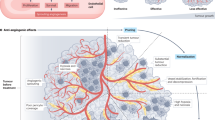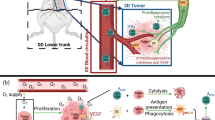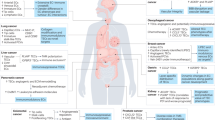Abstract
Angiogenesis is a crucial event in carcinogenesis and its onset has been associated with premalignant tumour stages. In order to elucidate the significance of angiogenesis in different stages of epithelial skin tumours, we analysed the vessel density in ten normal skin samples, 14 actinic keratosis (AK), 12 hypertrophic AKs, and in nine early- and 16 late-stage squamous cell carcinomas (SCCs). Mean vascular density was quantitated by counting the number of CD 31-immunostained blood vessels and by morphometric assessment of stained vessel area by computer-assisted image analysis. The results from both methods were well correlated. Mean vascular density was similar in normal dermis and in AK, and only slightly elevated in hypertrophic AKs and early SCC stages (tumour thickness < 2 mm). Only late-stage SCCs infiltrating the subcutis exhibited a significant increase in vascularization. Vessel density was independent of tumour localization, degree of proliferation and inflammatory cell infiltration. Furthermore, tumour vascularization was not correlated with the expression of vascular endothelial growth factor, a major angiogenic factor, as revealed by in situ hybridization and immunohistochemistry. The restriction of enhanced vascularization to increased tumour thickness may be a major reason for the rather low metastatic spread of cutaneous SCCs. © 2000 Cancer Research Campaign
Similar content being viewed by others
Article PDF
Change history
16 November 2011
This paper was modified 12 months after initial publication to switch to Creative Commons licence terms, as noted at publication
References
Barbareschi M, Weidner N, Gasparini G, Morelli L, Forti S, Eccher C, Fina P, Caffo O, Leonardi E, Mauri F, Bevilacqua P and Dalla Palma P (1995) Microvessel density quantification in breast carcinomas–assessment by light microscopy vs. a computer-aided image analysis system. Appl Immunohistochem 3: 75–84
Barnhill RL, Fandrey K, Levy MA, Mihm MC and Hyman B (1992) Angiogenesis and tumour progression of melanoma–quantification of vascularity in melanocytic nevi and cutaneous malignant melanoma. Lab Invest 67: 331–337
Barnhill RL and Levy M (1993) Regressing thin cutaneous malignant melanomas (1 mm) are associated with angiogenesis. Am J Pathol 143: 99–104
Boukamp P, Peter W, Pascheberg U, Altmeier S, Fasching C, Stanbridge EJ and Fusenig NE (1995) Step-wise progression in human skin carcinogenesis in vitro involves mutational inactivation of p53, ras H oncogene activation and additional chromosome loss. Oncogene 11: 961–969
Breuninger H, Black B and Rassner G (1990) Microstaging of squamous cell carcinomas. Am J Clin Pathol 94: 624–627
Broders AC (1932) Practical points on microscopic grading of carcinoma. N Y State J Med 32: 667–671
Brown LF, Yeo KT, Berse B, Yeo TK, Senger DR, Dvorak HF and Van de Water L (1992) Expression of vascular permeability factor (vascular endothelial growth factor) by epidermal keratinocytes during wound healing. J Exp M 176: 1375–1379
Callen JP (1991) Possible precursors to epidermal malignancies. In: Cancer of the Skin, Friedman RJ, Rigel DS, Kopf AW Harris MN, Baker D (eds), pp. 27–34. WB Saunders: Philadelphia
Carrau RL, Barnes EL, Snyderman CH, Petruzelli G, Kachman K, Rueger R, D'Amico F and Johnson JT (1995) Tumor angiogenesis as a predictor of tumor aggressiveness and metastatic potential in squamous cell carcinoma of the head and neck. Invasion Metastasis 15: 197–202
Coussens LM, Hanahan D and Arbeit JM (1996) Genetic predisposition and parameters of malignant progression in K14-HPV 16 transgenic mice. Am J Pathol 149: 1899–1917
Detmar M, Brown LF, Claffey KP, Yeo KT, Kocher O, Jackman RW, Berse B and Dvorak HF (1994) Overexpression of vascular permeability factor/vascular endothelial growth factor and its receptors in psoriasis. J Exp Med 180: 1141–1146
Detmar M, Kiang-Teck Y, Nagy JA, Van de Water L, Brown LF, Berse B, Elicker BM, Ledbetter S and Dvorak HF (1995) Keratinocyte-derived vascular permeability factor (vascular endothelial growth factor) is a potent mitogen for dermal microvascular endothelial cells. J Invest Dermatol 105: 44–50
Detmar M, Brown LF, Berse B, Jackman RW, Elicker BM, Dvorak HF and Claffey KP (1997) Hypoxia regulates the expression of vascular permeability factor/vascular endothelial growth factor (VPF/VEGF) and its receptors in human skin. J Invest Dermatol 108: 263–268
DeYoung BR, Wick MR, Fitzgibbon JF, Sirgi KE and Swanson PE (1993) CD31: an immunospecific marker for endothelial differentiation in human neoplasms. Appl Immunohistochem 1: 97–100
Ellis LM and Fidler IJ (1996) Angiogenesis and metastasis. Eur J Cancer 32A: 2451–2460
Folkman J (1995) Angiogenesis in cancer, vascular, rheumatoid and other disease. Nat Med 1: 27–31
Fusenig NE and Boukamp P (1998) Multiple stages and genetic alterations in immortalization, malignant transformation, and tumour progression of human skin keratinocytes. Mol Carcinogen 23: 144–158
Gasparini G, Weidner N, Maluta S, Pozza F, Boracchi P, Mezzetti M, Testolin A and Bevilacqua P (1993) Intratumoral microvessel density and p53 protein: correlation with metastasis in head and neck squamous cell carcinoma. Int J Cancer 55: 739–744
Goepfert H, Dichtel W, Medina JE, Landberg RD and Luna MD (1984) Perineural invasion of SCC of the head and neck. Am J Surg 148: 542–547
Graham CH, Rivers J, Kerbel RS, Stankiewicz KS and White WL (1994) Extent of vascularization as an independent prognostic indicator in thin (0.76 mm) malignant melanomas. Am J Pathol 145: 510–514
Guidi AJ, Fischer L, Harris JR and Schnitt SJ (1994) Microvessel density and distribution in ductal carcinoma in situ of the breast. J Natl Cancer Inst 86: 614–619
Hamada J, Cavanaugh PG, Lotan O and Nicolson GL (1992) Separable growth and migration factors for large-cell lymphoma cells secreted by microvascular endothelial cells derived from target organs for metastasis. Br J Cancer 66: 349–354
Hanahan D and Folkman J (1996) Patterns and emerging mechanisms of the angiogenic switch during tumorigenesis. Cell 86: 353–364
Hsu SM and Soban E (1982) Color modification of diaminobenzidine (DAB) precipitation by metallic ions and its application for double immunohistochemistry. J Histochem Cytochem 30: 1079–1082
Keck PJ, Hauser SD, Krivi G, Sanzo K, Waren T, Feder J and Connolly DT (1989) Vascular permeability factor, an endothelial cell mitogen related to PDGF. Science 246: 1309–1312
Kerschmann RL, McCalmont TH and LeBoit PE (1994) p53 oncoprotein expression and proliferation index in keratoacanthoma and squamous cell carcinoma. Arch Dermatol 130: 181–186
Marcoval J, Moreno A, Graells J, Vidal A, Escriba JM, Garcia-Ramirez M and Fabra A (1997) Angiogenesis and malignant melanoma. Angiogenesis is related to the development of vertical (tumorigenic) growth phase. J Cutan Path 24: 212–218
Marks R, Rennie G and Selwood TS (1988) Malignant transformation of solar keratoses to squamous cell carcinoma. Lancet 1: 795–797
Moorman AFM, De-Boer PAJ, Vermeulen JLM and Lamers WH (1992) Practical aspects of radio-isotopic in situ hybridization on RNA. Histochem J 25: 251–266
Pyke C, Kristensen P, Ralfkiaer E, Eriksen J and Dano K (1991) The plasminogen activation system in human colon cancer: messenger RNA for the inhibitor PAI-1 is located in endothelial cells in the tumour stroma. Cancer Res 51: 4067–4071
Rak J, Filmus J and Kerbel RS (1996) Reciprocal paracrine interactions between tumour cells and endothelial cells: the ‘angiogenesis progression’ hypothesis. Eur J Cancer 32A: 2438–2450
Schlenger K, Höckel M, Mitze M, Schäffer J, Weikel W, Knapstein PG and Lambert A (1995) Tumor vascularity – a novel prognostic factor in advanced cervical carcinoma. Gynecol Oncol 59: 57–66
Skobe M, Rockwell P, Goldstein N, Vosseler S and Fusenig NE (1997) Halting angiogenesis suppresses carcinoma cell invasion. Nature Med 3: 1222–1227
Smith-McCune K and Weidner N (1994) Demonstration and characterization of the angiogenic properties of cervical dysplasia. Cancer Res 54: 800–804
Smith-McCune K, Zhu Y-H, Hanahan D and Arbeit J (1997) Cross-species comparison of angiogenesis during the premalignant stages of squamous carcinogenesis in the human cervix and K14-HPV16 transgenic mice. Cancer Res 57: 1294–1300
Srivastava A, Laidler P, Davies RP, Horgan K and Hughes LE (1988) The prognostic significance of tumour vascularity in intermediate-thickness (0.76–4.0 mm thick) skin melanoma. Am J Pathol 133: 419–423
Staibano S, Boscaino A, Salvatore G, Orabona P, Palombini L and De Rosa G (1996) The prognostic significance of tumour angiogenesis in nonaggressive and aggressive basal cell carcinoma of the human skin. Hum Pathol 27: 695–700
Tahan SR and Stein AL (1995) Angiogenesis in invasive squamous cell carcinoma of the lip: tumor vascularity is not an indicator of metastatic risk. J Cutan Path 22: 236–240
Urbach F and Graham JH (1962) Anatomy of human skin tumour capillaries. Nature 194: 652–654
Van Hoef MEHM, Knox WF, Dhesi SS, Howell A and Schor AM (1993) Assessment of tumour vascularity as a prognostic factor in lymph node negative invasive breast cancer. Eur J Cancer 29A: 1141–1145
Vermeulen PB, Gasparini G, Fox SB, Toi M, Martin L, McCulloch P, Pezella F, Viale G, Weidner N, Harris AL and Dirix LY (1996) Quantification of angiogenesis in solid human tumours: an international consensus on the methodology and criteria of evaluation. Eur J Cancer 32A: 2474–2484
Weedon D (1997) Tumors of the epidermis. In: Skin Pathology, Weedon D (ed) pp. pp. 642–671. Churchill Livingstone: Edinburgh
Weidner N (1995) Intratumor microvessel density as a prognostic factor in cancer. Am J Pathol 147: 9–19
Weidner N, Semple JP, Welch WR and Folkman J (1991) Tumour angiogenesis and metastasis – correlation in invasive breast carcinoma. N Engl J Med 324: 1–8
Weninger W, Uthman A, Pammer J, Pichler A, Ballaun C, Lang IM, Plettenberg A, Bankl HC, Stürzl M and Tschachler E (1996) Vascular endothelial growth factor production in normal epidermis and in benign and malignant epithelial skin tumours. Lab Invest 75: 647–657
Weninger W, Rendl M, Pammer J, Grin W, Petzelbauer P and Tschachler E (1997) Differences in tumor microvessel density between squamous cell carcinomas and basal cell carcinomas may relate to their different biologic behavior. J Cutan Pathol 24: 364–369
Zätterström UK, Brun E, Willen R, Kjellen E and Wennerberg J (1995) Tumor angiogenesis and prognosis in squamous cell carcinoma of the head and neck. Head Neck 17: 312–318
Ziegler A, Jonason AS, Leffell DJ, Simon JA, Sharma HW, Kimmelman J, Remington L, Jacks T and Brash DE (1994) Sunburn and p53 in the onset of skin cancer. Nature 372: 773–776
Author information
Authors and Affiliations
Rights and permissions
From twelve months after its original publication, this work is licensed under the Creative Commons Attribution-NonCommercial-Share Alike 3.0 Unported License. To view a copy of this license, visit http://creativecommons.org/licenses/by-nc-sa/3.0/
About this article
Cite this article
Strieth, S., Hartschuh, W., Pilz, L. et al. Angiogenic switch occurs late in squamous cell carcinomas of human skin. Br J Cancer 82, 591–600 (2000). https://doi.org/10.1054/bjoc.1999.0969
Received:
Revised:
Accepted:
Published:
Issue date:
DOI: https://doi.org/10.1054/bjoc.1999.0969
Keywords
This article is cited by
-
Topical treatment of actinic keratoses with potassium dobesilate 5% cream. a preliminary open-label study
European Journal of Medical Research (2011)
-
HIF-1α in Epidermis: Oxygen Sensing, Cutaneous Angiogenesis, Cancer, and Non-Cancer Disorders
Journal of Investigative Dermatology (2011)
-
Carcinoma-like vascular density in atypic keratoacanthoma suggests malignant progression
British Journal of Cancer (2002)



